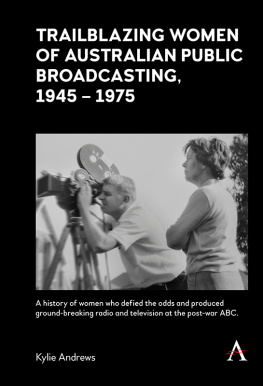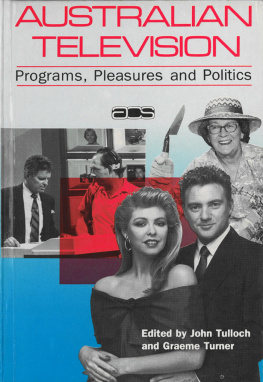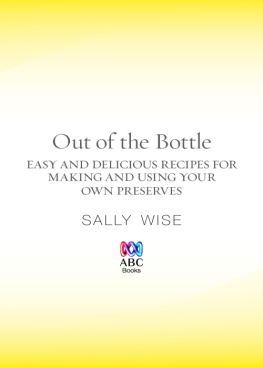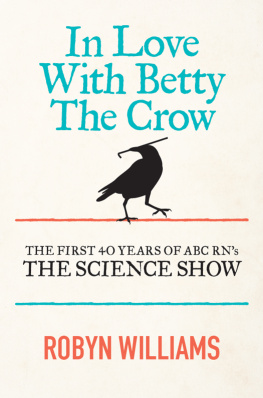Trailblazing Women of Australian Public Broadcasting, 19451975
A history of women who defied the odds and produced ground-breaking radio and television at the post-war ABC
Trailblazing Women of Australian Public Broadcasting, 19451975
A history of women who defied the odds and produced ground-breaking radio and television at the post-war ABC
Kylie Andrews
Anthem Press
An imprint of Wimbledon Publishing Company
www.anthempress.com
This edition first published in UK and USA 2022
by ANTHEM PRESS
7576 Blackfriars Road, London SE1 8HA, UK
or PO Box 9779, London SW19 7ZG, UK
and
244 Madison Ave #116, New York, NY 10016, USA
With assistance from the Australian Academy of Humanities
Copyright Kylie Andrews 2022
The author asserts the moral right to be identified as the author of this work.
All rights reserved. Without limiting the rights under copyright reserved above, no part of this publication may be reproduced, stored or introduced into a retrieval system, or transmitted, in any form or by any means (electronic, mechanical, photocopying, recording or otherwise), without the prior written permission of both the copyright owner and the above publisher of this book.
British Library Cataloguing-in-Publication Data
A catalogue record for this book is available from the British Library.
Library of Congress Cataloging-in-Publication Data
A catalog record for this book has been requested.
ISBN-13: 978-1-83998-257-6 (Hbk)
ISBN-10: 1-83998-257-8 (Hbk)
Cover Image: Therse Denny, 1963,
National Archives of Australia: SP1011/1, 797
Cover Credit: National Archives of Australia: SP1011/1, 797
This title is also available as an e-book.
Aboriginal and Torres Strait Islander readers are advised that the following research contains names and images of people who have died.
CONTENTS
ABC Australian Broadcasting Commission
ASIO Australian Security Intelligence Organisation
AWBC Australian Womens Broadcasting Co-Operative
BBC British Broadcasting Corporation
BBC WAC BBC Written Archives Centre
CBC Canadian Broadcasting Corporation
EBU European Broadcasting Union
FAC ABC Film Assessment Committee
NAA National Archives of Australia
NLA National Library of Australia
RDF Radio Diffusion Franaise
SLWA State Library of Western Australia
When I started writing this book, I had never heard of Kay Kinane, Catherine King, Therse Denny and Joyce Belfrage. Before becoming a historian, I worked for more than a dozen years in media production and, like so many of my female colleagues, was unaware of the achievements and efforts of my trailblazing predecessors. A few years ago, I was talking to one of Australias leading film producers a woman who started her career at the ABC in the 1970s and asked if she had been inspired by any of the earlier generations of radio and television producers. She confessed she had never heard of them. Why have women been so absent in histories of media production? In the post-war decades, Australian broadcasting expanded into an increasingly complex and diverse industry, requiring a variety of workers and specialists. Surely, women workers made substantial contributions? The journey for this book began with a search to discover if the lack of women in Australian media history was, in fact, an accurate representation of their actual contributions over the decades. I discovered that for much of the twentieth century, Australias media histories often ignore the contributions of women behind the scenes. As film scholar Annette Blonski lamented, so much of our history exists merely as footnotes to accounts of the exploits of famous men.
Early in my research, I came across ABC commentator Ellis Blains 1977 memoir, Life with Aunty: Forty Years with the ABC. In the opening paragraph, Blain wrote, Talking to some of the men who have shaped the ABC of today soon convinced me that I had been wise to avoid a commitment to a history in depth. Many of those who should have contributed to such an enterprise are already dead, and some of those who are alive make no secret of their determination that the mistakes, politics and intrigues will continue to rest in peace. When I read this, I was immediately struck by Blains determination that it was men who built the ABC. I was also disconcerted by the preferred practice of forgetting uncomfortable aspects of the past. It was a timely reminder of the need to revise the limited historical narratives which selectively celebrate the good and ignore the more complex aspects of an organisations history, even one as well-intentioned as the ABC. This book celebrates womens contributions to Australian broadcasting and the important role public broadcasting has played in Australia.
Thankfully, more historians are remedying what Michele Hilmes identified as the blind spot of gender in broadcasting; working to exhume women from historical neglect and resuscitating their contributions as producers of content. Despite the fact that so many were invisible in traditional broadcasting histories, I soon discovered numerous instances of female ambition and agency; women who, in a multitude of ways, contributed to the development of Australian public broadcasting in the decades after World War II. This book functions as a womens history as well as a feminist history. It performs an act of recovery, working to remedy the deficit of histories featuring Australian women broadcasters. It also reimagines the nature of womens work at the ABC and revises historical narratives that privilege male broadcasters. By reclaiming the careers of women like these dynamic producers, we can view Australian public broadcasting with a fresh perspective, a womans perspective.
Many people provided me with assistance and inspiration as I wrote this book. I am most grateful to Paula Hamilton and Paul Ashton for their guidance and encouragement. I would also like to thank the team at the Centre for Public History and the generous community of historians and media scholars who welcomed me. A special vote of thanks goes to Bridget Griffen-Foley, Zora Simic, Jeannine Baker, Liz Giuffre and Peter Cochrane. The Australian Historical Association and the Australian Copyright Agency also provided me with invaluable assistance; their support for early career researchers like myself has been wonderful.
This history would not have been possible without the support of the University of Technology, Sydney, via a Vice-Chancellors Research Scholarship and an Australian Government Research Training Programme Scholarship. I am also grateful to have been endowed with the 2018 Clare Burton Award, through the Australian Technology Network of Universities. I was inspired by Clares legacy to encourage gender equity and improve the lives of working women. I have received assistance from both The Australian Academy of Humanities and the International Australian Studies Association, many thanks for your support.
I would like to thank the archivists who were so generous with their time. Special thanks go to the National Archive of Australias Judith Paterson and Edmund Rutledge. I am indebted to the marvellous people at the ABC, especially Guy Tranter and Janine Crichley. Many thanks to Graham Shirley for permitting me to utilize his collection of interviews with Australian broadcasters and filmmakers. Thanks also to the National Film and Sound Archive, the National Library of Australia, the British Film Institute, the BBC Written Archives Centre and the Tamiment Library/Robert F. Wagner Labor Archives at New York University.












